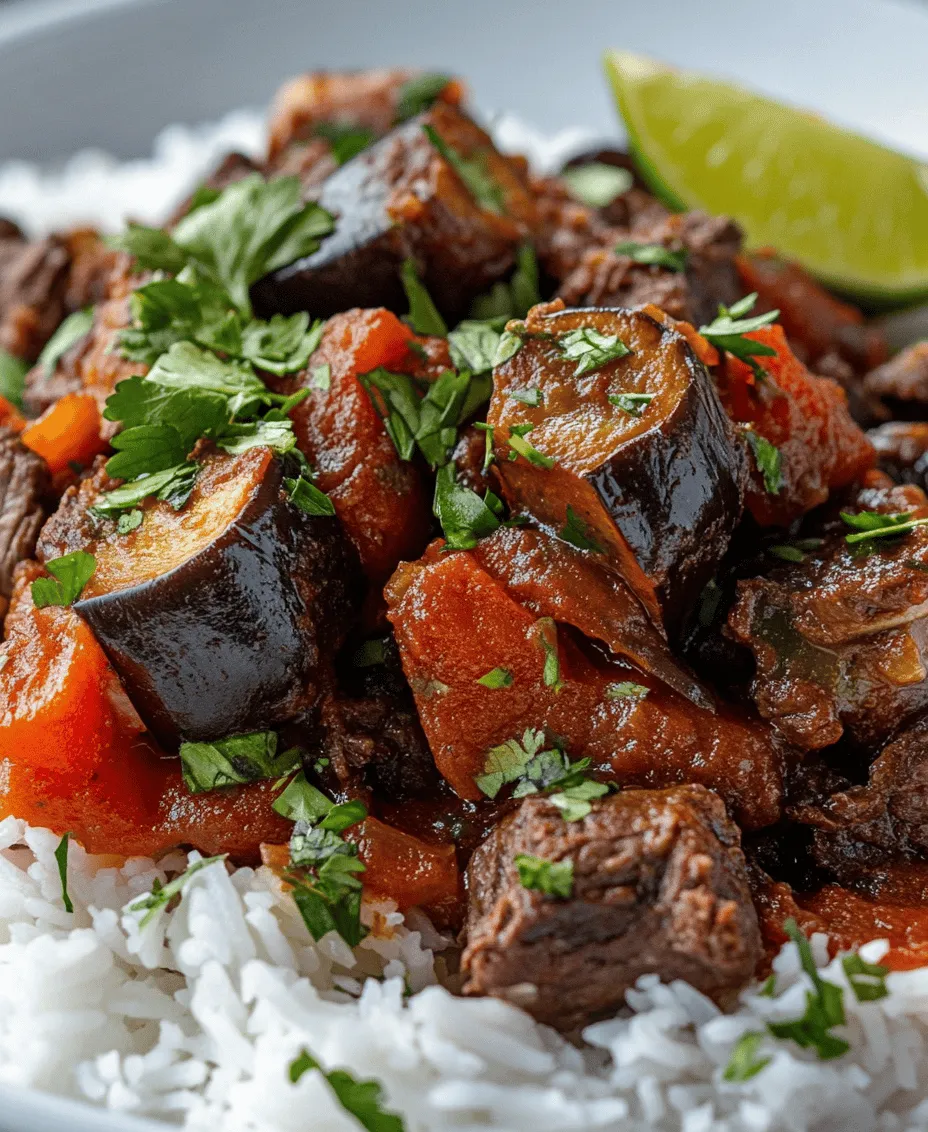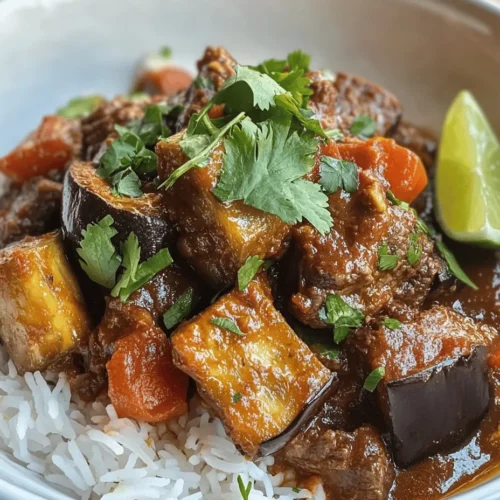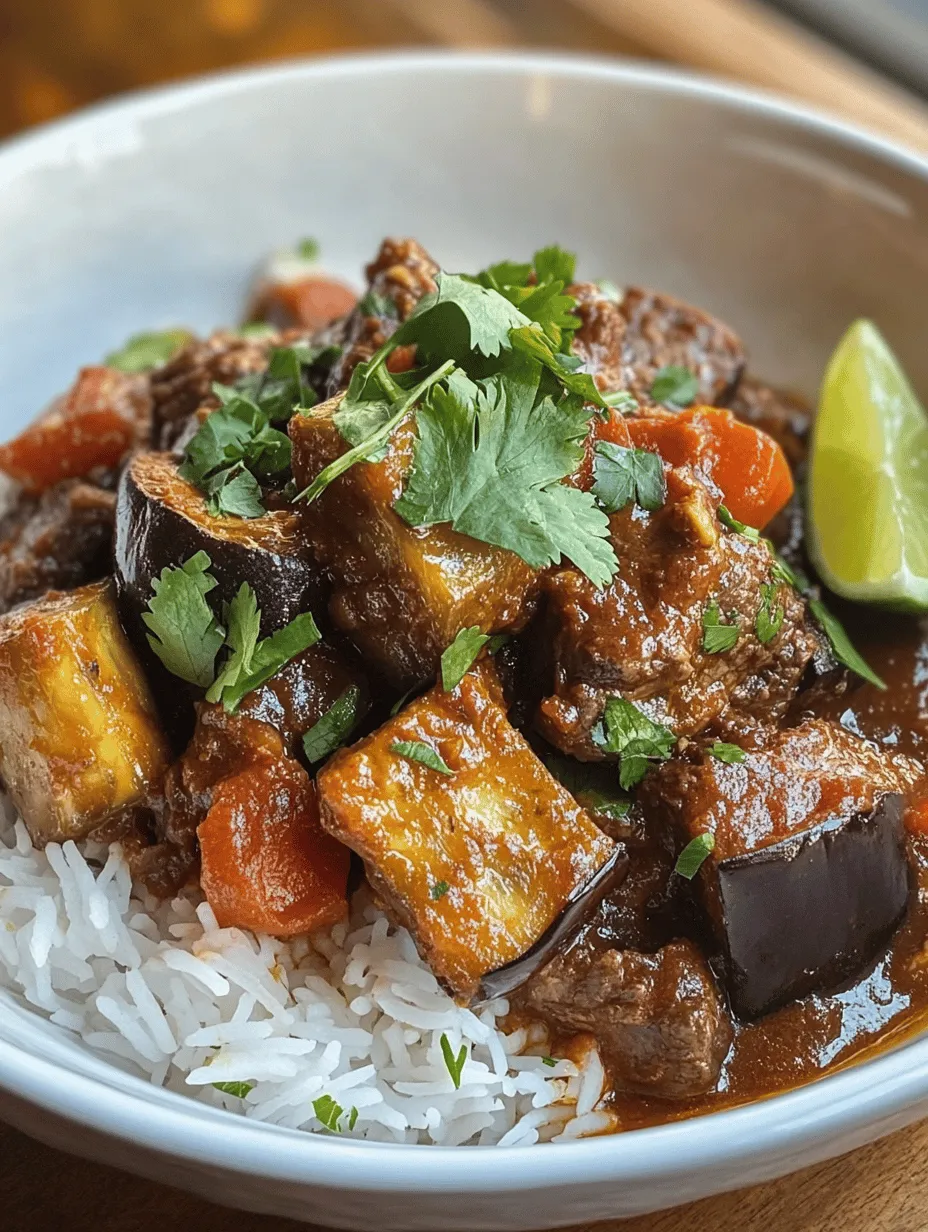Khoresh Bademjan is a traditional Persian dish that embodies the rich tapestry of flavors and culinary heritage found in Persian cuisine. This delicious eggplant stew is not just a meal; it is a celebration of the ingredients that define Persian cooking. The dish typically combines tender chunks of meat, flavorful eggplants, and a blend of aromatic spices, resulting in a stew that is both comforting and complex. It is commonly enjoyed with a side of steamed basmati rice, making it a staple for both everyday dining and special occasions.
The cultural significance of Khoresh Bademjan runs deep within Iranian tradition. It represents the warmth of Persian hospitality, often served during family gatherings and festive celebrations. The unique combination of flavors—from the earthiness of the eggplant to the aromatic spices—creates a dish that tantalizes the palate. Moreover, eggplants offer not only delightful texture but also numerous health benefits. They are rich in dietary fiber, vitamins, and antioxidants, making them an excellent addition to any diet.
As we delve into this recipe, we will explore the key ingredients that contribute to Khoresh Bademjan’s distinctive flavor profile and discuss the techniques that elevate this dish into a culinary masterpiece. The interplay of spices, the choice of meat, and the preparation of eggplants all play crucial roles in crafting this dish.
Understanding the Ingredients of Khoresh Bademjan
Exploring Eggplants: Types and Preparation Techniques
Eggplants, also known as aubergines, are a staple in Persian cooking, and they serve as the main ingredient in Khoresh Bademjan. Various types of eggplants can be used, but the most common varieties include globe eggplants and Persian eggplants. Globe eggplants are larger and have a thicker skin, while Persian eggplants are smaller, thinner, and often have a sweeter flavor. Each type brings its unique characteristics to the dish.
Before incorporating eggplants into the stew, it is essential to prepare them properly. One widely used technique in Persian cuisine is salting the eggplants. Salting helps to draw out excess moisture and bitterness from the eggplants, enhancing their flavor and improving their texture. To do this, slice the eggplants into thick rounds or cubes, sprinkle them generously with salt, and let them sit for about 30 minutes. Afterward, rinse and pat them dry. This simple step is vital as it prevents the eggplants from becoming overly soggy during cooking and ensures they absorb the flavors of the stew beautifully.
The Importance of Meat Choices: Beef or Lamb
Khoresh Bademjan traditionally features either beef or lamb, both of which contribute to the stew’s rich and hearty nature. The choice between the two often comes down to personal preference and regional variations. Beef tends to offer a more robust flavor, while lamb is more tender and has a slightly gamey taste that can add depth to the dish.
When preparing Khoresh Bademjan, it is crucial to consider the cooking times for different types of meat. Beef typically requires a longer cooking time to become tender, while lamb cooks faster. For a vegetarian variation, you can substitute the meat with chickpeas or lentils, which will still provide a hearty texture and absorb the delicious flavors of the stew.
Aromatic Spices: Turmeric, Cinnamon, and Dried Persian Lime
The heart of Khoresh Bademjan’s flavor lies in its aromatic spices. Turmeric, cinnamon, and dried Persian lime are the key spices that elevate this dish.
– Turmeric is known for its vibrant yellow color and earthy flavor. It is a staple in Persian cooking, celebrated for its anti-inflammatory properties and potential health benefits. Its warm notes complement the richness of the meat and the creaminess of the eggplants.
– Cinnamon adds a sweet and warm undertone that balances the savory elements of the dish. Its unique flavor is often associated with Middle Eastern cuisine and plays a crucial role in layering the flavors of Khoresh Bademjan.
– Dried Persian lime, or “limoo amani,” is another essential ingredient. These limes are dried whole and have a distinct tartness that enhances the stew’s acidity. The use of dried lime not only adds a unique flavor but also provides a touch of authenticity to the dish.
These spices, when combined, create a symphony of flavors that define Khoresh Bademjan, making it a beloved dish among Persian food enthusiasts.
Understanding the Role of Tomatoes and Broth
Tomatoes play a significant role in Khoresh Bademjan, contributing acidity and balancing the rich flavors of the meat and eggplants. The use of fresh tomatoes or canned tomatoes provides a base for the stew, helping to create a luscious sauce that envelops the ingredients.
When it comes to the choice of liquid in the stew, using beef broth instead of water can significantly enhance the overall flavor profile. Beef broth adds depth and richness, while water may dilute the flavors. If you are opting for a vegetarian version, vegetable broth is a great alternative that will still provide the necessary flavor without the meat.
Step-by-Step Guide to Making Khoresh Bademjan
Preparation of Eggplants: Salting and Drying
The first step in preparing Khoresh Bademjan involves salting the eggplants, as discussed earlier. This process is crucial to achieving the perfect texture. By salting the eggplants, you not only reduce bitterness but also enhance their ability to absorb the flavors of the stew. After slicing the eggplants, sprinkle them with salt and let them sit for about 30 minutes. You’ll notice that moisture will begin to seep out, which is a good sign. Once the time is up, rinse the eggplants under cold water and pat them dry with a paper towel to remove excess salt.
Sautéing the Eggplants: Achieving Perfect Texture
Once the eggplants are prepared, it’s time to sauté them. Heat a generous amount of oil in a large skillet over medium-high heat. The oil should be hot but not smoking. Add the eggplants in batches, ensuring not to overcrowd the pan. Fry the eggplants until they are golden brown on all sides, which will take about 5-7 minutes. This step is essential, as frying the eggplants not only adds a rich flavor but also creates a desirable texture. Once cooked, transfer the eggplants to a plate lined with paper towels to drain excess oil.
Cooking the Base: Sautéing Onions and Garlic
The next step involves building the flavor base for Khoresh Bademjan. In the same skillet, add a bit more oil if necessary and lower the heat to medium. Add thinly sliced onions and sauté until they become soft and translucent, about 5-7 minutes. The sweetness of the onions will add depth to the stew. Once the onions are fragrant, add minced garlic and sauté for an additional minute until it becomes aromatic. This step is crucial, as properly sautéed onions and garlic create a flavorful foundation for the entire dish.
Browning the Meat: The Foundation of Flavor
After the onions and garlic have cooked down, it’s time to add the meat. Increase the heat to medium-high and add the beef or lamb to the skillet, browning it on all sides. This process helps to seal in the juices and creates a rich, flavorful crust that enhances the overall taste of the stew. The browning should take about 5-8 minutes. Once the meat is browned, you can deglaze the pan with a splash of water or broth, scraping up any flavorful bits stuck to the bottom of the skillet.
Incorporating Spices: Timing and Technique
Once the meat is browned, it’s time to add the spices. Sprinkle in the turmeric and cinnamon, stirring to coat the meat evenly. This step is vital, as it allows the spices to bloom in the heat, releasing their essential oils and flavors. After a minute, add the prepared eggplants back into the skillet along with diced tomatoes and the dried Persian lime. Pour in the beef broth or water, ensuring that the ingredients are submerged.
As you prepare Khoresh Bademjan, remember that patience is key. Allow the stew to simmer gently, letting the flavors meld together, and creating a comforting and hearty dish that captures the essence of Persian cuisine.
With this foundational understanding and the initial steps laid out, you are now equipped to embark on the journey of crafting your own Khoresh Bademjan, a dish that truly embodies the spirit of Persian cooking. Stay tuned for the next part of this article, where we will continue to explore the final steps and tips for achieving the perfect eggplant stew.

Simmering to Perfection: The Key to Tender Meat
Simmering is a crucial technique in cooking Khoresh Bademjan, as it allows the flavors to meld beautifully while ensuring the meat becomes tender and succulent. After you have added your spices—cumin, turmeric, and black pepper—it’s important to give them time to infuse their flavors into the meat. When you simmer your stew gently, the low heat breaks down the connective tissues in tougher cuts of meat, making them soft and juicy.
For Khoresh Bademjan, aim to simmer the stew for at least 1.5 to 2 hours. This slow cooking process not only develops the stew’s rich flavor but also allows the spices to bloom fully, enhancing the overall taste. During this time, make sure to occasionally stir the stew gently to prevent sticking and ensure an even distribution of flavors. The aroma that fills your kitchen will undoubtedly make your mouth water, setting the stage for a delightful dining experience.
Final Assembly: Merging Eggplants and Stew
Once your meat is beautifully tender and the flavors are harmonizing, it’s time to incorporate the fried eggplants back into the stew. This step is significant because it allows the eggplants to absorb the rich flavors of the khoresh, blending their creamy texture with the hearty meat and sauce.
Carefully place the fried eggplants into the simmering stew, ensuring they are evenly distributed. Allow the dish to simmer together for an additional 15 to 20 minutes. This final melding of ingredients is crucial; it not only enhances the flavor of the eggplants but also helps them to soften slightly, making them a perfect complement to the tender meat.
Once completed, your Khoresh Bademjan will boast a deep, luscious gravy, with the eggplants beautifully integrated into the dish, ready to be served.
Serving Suggestions: How to Enjoy Khoresh Bademjan
Khoresh Bademjan is a versatile dish that can be enjoyed in various ways, making it a staple in Persian cuisine. Traditionally, it is served with fluffy basmati rice, which plays a significant role in the overall experience.
Pairing with Rice: The Classic Persian Way
In Persian culture, rice is more than just a side dish; it is the heart of the meal. The long-grain basmati rice, with its fragrant aroma and fluffy texture, perfectly complements the rich and savory stew. To prepare your rice, rinse it thoroughly until the water runs clear to remove excess starch. Soak the rice in water for about 30 minutes before cooking to achieve the desired fluffy texture.
Once your rice is cooked, serve it alongside your Khoresh Bademjan, allowing diners to spoon the stew over the rice. This combination not only enhances the flavor but also provides a wonderful contrast in textures—the creaminess of the eggplants, the tenderness of the meat, and the light fluffiness of the rice.
Garnishing for Flavor and Presentation
Garnishing your Khoresh Bademjan elevates both its visual appeal and flavor profile. Fresh herbs like parsley or cilantro can be finely chopped and sprinkled on top just before serving. Not only do these herbs add a pop of color to the dish, but they also introduce a fresh, vibrant flavor that balances the richness of the stew. A squeeze of fresh lemon juice can also brighten the dish, enhancing its complexity.
Accompaniments: Bread, Salads, and Pickles
Khoresh Bademjan pairs beautifully with various accompaniments that enhance the overall dining experience. Traditional Persian bread, such as lavash or barbari, is perfect for scooping up the stew. A side salad, like Shirazi salad, made from diced cucumbers, tomatoes, and onions dressed with lemon juice and olive oil, adds a refreshing crunch that contrasts with the stew’s richness.
Pickles, particularly torshi (Persian pickled vegetables), can also be served alongside to add acidity and brightness, cutting through the savory flavors of the khoresh. These complementary dishes create a well-rounded meal, showcasing the diversity of Persian cuisine.
Cultural Significance of Khoresh Bademjan in Persian Cuisine
Khoresh Bademjan is more than just a delightful dish; it holds a significant place in Persian culture and history. Often associated with family gatherings and celebrations, this stew embodies the warmth of Persian hospitality.
Traditional Occasions and Celebrations
Khoresh Bademjan is commonly served during special occasions such as weddings, family gatherings, and religious celebrations. Its communal nature encourages sharing and togetherness, making it a beloved dish in Persian households. The preparation of this stew often involves the participation of family members, fostering connections and creating lasting memories around the dinner table.
Regional Variations: How Khoresh Bademjan Differs Across Iran
Across Iran, Khoresh Bademjan can vary significantly in ingredients and preparation methods. In regions like Isfahan, the stew may be made with lamb and seasoned with local spices, while in the southern provinces, it might include a touch of tanginess from tamarind or pomegranate molasses. These regional variations reflect the diversity of Iranian cuisine and the unique flavors found in different parts of the country.
Nutritional Benefits of Khoresh Bademjan
Khoresh Bademjan is not only delicious but also offers a variety of nutritional benefits thanks to its wholesome ingredients.
Nutritional Breakdown of Ingredients
Eggplants are the star of this dish, packed with vitamins, minerals, and antioxidants. They are low in calories and high in fiber, making them an excellent choice for a healthy diet. The addition of meat provides a source of protein and essential nutrients like iron and zinc. The spices used in Khoresh Bademjan, such as turmeric and cumin, are known for their anti-inflammatory and antioxidant properties, adding to the dish’s health benefits.
Health Benefits of Persian Cuisine
Persian cuisine emphasizes the use of fresh ingredients, herbs, and spices, promoting a balanced and healthy diet. Meals are often rich in vegetables, whole grains, and lean meats, contributing to overall well-being. The focus on flavor and nutrition in Persian cooking makes dishes like Khoresh Bademjan not only satisfying but also beneficial for health.
Conclusion: Embracing Khoresh Bademjan in Your Kitchen
Khoresh Bademjan is a culinary treasure that encapsulates the richness of Persian flavors and traditions. Its harmonious blend of tender meat, creamy eggplants, and aromatic spices creates a dish that is both comforting and indulgent. Cooking this stew is not just about following a recipe; it’s about embracing the joy of preparing and sharing a meal that holds cultural significance.
Encouraging readers to explore Persian cuisine fosters a deeper appreciation for its diverse flavors and communal nature. By preparing Khoresh Bademjan, you are not only creating a delicious meal but also participating in a culinary legacy that celebrates family, community, and hospitality. So gather your loved ones, share this delightful dish, and embrace the warmth and richness of Persian cooking in your kitchen.



